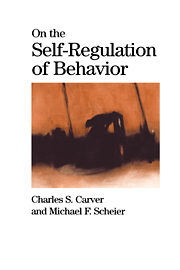Book contents
- Frontmatter
- Contents
- Preface
- Acknowledgments
- 1 Introduction and Plan
- 2 Principles of Feedback Control
- 3 Discrepancy-Reducing Feedback Processes in Behavior
- 4 Discrepancy-Enlarging Loops, and Three Further Issues
- 5 Goals and Behavior
- 6 Goals, Hierarchicality, and Behavior: Further Issues
- 7 Public and Private Aspects of the Self
- 8 Control Processes and Affect
- 9 Affect: Issues and Comparisons
- 10 Expectancies and Disengagement
- 11 Disengagement: Issues and Comparisons
- 12 Applications to Problems in Living
- 13 Hierarchicality and Problems in Living
- 14 Chaos and Dynamic Systems
- 15 Catastrophe Theory
- 16 Further Applications to Problems in Living
- 17 Is Behavior Controlled or Does It Emerge?
- 18 Goal Engagement, Life, and Death
- References
- Name Index
- Subject Index
1 - Introduction and Plan
Published online by Cambridge University Press: 05 June 2012
- Frontmatter
- Contents
- Preface
- Acknowledgments
- 1 Introduction and Plan
- 2 Principles of Feedback Control
- 3 Discrepancy-Reducing Feedback Processes in Behavior
- 4 Discrepancy-Enlarging Loops, and Three Further Issues
- 5 Goals and Behavior
- 6 Goals, Hierarchicality, and Behavior: Further Issues
- 7 Public and Private Aspects of the Self
- 8 Control Processes and Affect
- 9 Affect: Issues and Comparisons
- 10 Expectancies and Disengagement
- 11 Disengagement: Issues and Comparisons
- 12 Applications to Problems in Living
- 13 Hierarchicality and Problems in Living
- 14 Chaos and Dynamic Systems
- 15 Catastrophe Theory
- 16 Further Applications to Problems in Living
- 17 Is Behavior Controlled or Does It Emerge?
- 18 Goal Engagement, Life, and Death
- References
- Name Index
- Subject Index
Summary
Throughout our careers we've been interested in the structure of behavioral self-regulation. Sometimes when relatives or acquaintances ask us what we do for a living, we use that phrase. Often enough, what we get in return is a blank look. In truth, it's a pretty abstract phrase. It's hard to know what it means unless you already know what it means. The term self-regulation in itself says more than we intend. After all, control of such qualities as body temperature, blood pressure, and blood chemistry all represent self-regulation. But these aren't what we're interested in.
Even adding the qualifier behavioral to self-regulation doesn't entirely solve the problem. This leaves a door open to a large body of work on the regulation of physical action – motor control. There are links between the processes of motor control and the processes we focus on (to carry out any kind of behavior, you somehow have to translate the intent to act into actual movement). Yet the topics are different enough to draw a line between them. For the most part, movement control is outside our focus.
Behavioral self-regulation in this book concerns mostly behavior at the level of interest to personality–social (and health, organizational, clinical, and counseling) psychologists. The question we're interested in is how behavior – at that level of abstraction – happens. This restricts the topic a little. In another sense, though, we're using the word behavior broadly. We're interested both in action and in emotion.
- Type
- Chapter
- Information
- On the Self-Regulation of Behavior , pp. 1 - 9Publisher: Cambridge University PressPrint publication year: 1998
- 1
- Cited by



